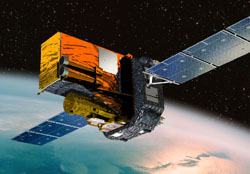Casting a Strange Glow

Stars made entirely of naked quarks could give off a unique signal that we may soon be able to detect. Researchers propose in the 23 September print issue of PRL that a young “strange” star would emit gamma rays for years at a time or perhaps longer, setting itself apart from other stars and astrophysical events. A satellite scheduled for launch next month should be sensitive to this energy range.
Exploded stars will sometimes collapse under their own gravity. If conditions are right, protons and electrons then fuse into neutrons, creating a neutron star. Theorists speculate that the collapse could proceed further if the matter became dense enough. Neutrons would dissolve into quark matter, allowing their constituent up and down quarks to roam free. According to one theory, some of the up quarks would turn into strange quarks, and a star made of so-called strange quark matter would result. But quark stars would be hard to distinguish from neutron stars, in part because the strange quark matter could be enveloped in a shell of normal matter. Two recent reports hinted at evidence for such strange stars based on analyses of their size or temperature [1] but a subsequent reappraisal indicated that neutron stars could have produced the signals [2].
Now Dany Page of the National Autonomous University of Mexico and Vladimir Usov of Israel’s Weizmann Institute of Science say they’ve found a better way to pick out strange stars, as long as they aren’t covered in normal matter. At the moment of formation, a quark star could be as hot as K. This heat would completely evaporate all normal matter from the surface except for electrons. The resulting electric field would create a plasma of electrons and positrons from among the virtual particles surrounding the star. The plasma in turn would produce gamma ray photons with energies from 30 to 500 keV.
The team models the evolution of a young strange star and concludes that its luminosity would gradually dim, though exactly how long that would take is unclear. In any case, Page says that such behavior would conclusively identify a strange star because no other known object produces such intense radiation for so long. “It may be much less bright than a gamma ray burst, but it can go on for years, maybe thousands of years.”
That might just be long enough for the European Space Agency’s INTEGRAL (INTErnational Gamma-Ray Astrophysics Laboratory) satellite to spot such stars. More sensitive than previous soft gamma ray detectors, INTEGRAL is currently set to launch on 17 October.
The odds of INTEGRAL observing the gamma rays from a strange star are hard to predict, says Madappa Prakash of the State University of New York at Stony Brook. Nobody knows how common the objects might be or how many would be old and dim by now. He also points out that although Page and Usov’s assumptions about strange star formation are plausible, no calculations exist yet to back them up. But the theory is worth testing, he says. It predicts a signal that can’t be confused with that of a normal star, “and that’s a good thing.”
–JR Minkel
JR Minkel is a freelance science writer in New York City.
References
- J. J. Drake et al., “Is RX J1856.5-3754 a Quark Star?,” Astrophys. J. 572, 996 (2002); P. Slane et al., “New Constraints on the Structure and Evolution of the Pulsar Wind Nebula 3C 58,” Astrophys. J. 616, 403 (2004)
- M. Prakash et al., “Observability of neutron stars with quarks,” Nucl. Phys. A 715, 835 (2003)


